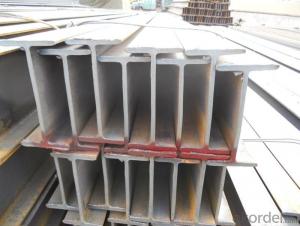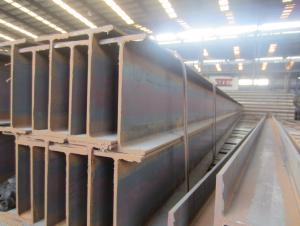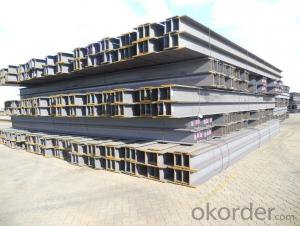Hot Rolled Steel channel H BEAM for sale Made In China
- Loading Port:
- Tianjin
- Payment Terms:
- TT or LC
- Min Order Qty:
- 50 m.t.
- Supply Capability:
- 10000 m.t./month
OKorder Service Pledge
OKorder Financial Service
You Might Also Like
Product Description:
OKorder is offering Hot Rolled Steel channel H BEAM for sale Made In China at great prices with worldwide shipping. Our supplier is a world-class manufacturer of steel, with our products utilized the world over. OKorder annually supplies products to European, North American and Asian markets. We provide quotations within 24 hours of receiving an inquiry and guarantee competitive prices.
Product Applications:
Hot Rolled Steel channel H BEAM for sale Made In China are ideal for structural applications and are widely used in the construction of buildings and bridges, and the manufacturing, petrochemical, and transportation industries.
Product Advantages:
OKorder's Hot Rolled Steel channel H BEAM for sale Made In China are durable, strong, and resist corrosion.
Main Product Features:
· Premium quality
· Prompt delivery & seaworthy packing (30 days after receiving deposit)
· Corrosion resistance
· Can be recycled and reused
· Mill test certification
· Professional Service
· Competitive pricing
Product Specifications:
1. Standard: GB700-88, Q235B2.
2. Grade: Q235, SS400 or Equivalent
3. Length: 6m,10m, 12m as following table
4. Invoicing on theoretical weight or actual weight as customer request
5.Payment: TT or L/C
6. Sizes:
SIZE(mm) | DIMENSION(kg/m) |
100*100 | 16.9 |
125*125 | 23.6 |
150*75 | 14 |
150*150 | 31.1 |
148*100 | 20.7 |
198*99 | 17.8 |
200*100 | 20.9 |
248*124 | 25.1 |
250*125 | 29 |
Packaging & Delivery of Hot Rolled Steel H BEAM
1. Packing: it is nude packed in bundles by steel wire rod
2. Bundle weight: not more than 3.5MT for bulk vessel; less than 3 MT for container load
3. Marks:Color marking: There will be color marking on both end of the bundle for the cargo delivered by bulk vessel. That makes it easily to disting Applications of H BEAM:
The MS Channel can be applied to construction of warehouses, workshops, sport stadiums and car parks etc.The hot rolled channel steel belongs to carbon structural steel which is applied to in the field of construction and machinery.In details, the hot rolled channel steel is usually used for arch-itechtural structure, and they could be welded in order to support or hang a vari-ety of facilities. They are also usually used in combination with I beam. Generally,the hot rolled channel steel we supply must possess perfect welding property, riveting property and mechanical property and so on.
Package & Delivery of H BEAM:
1.The hot rolled channel steel will be packed in bundle with steel wire at each end of every bundle and color marking in order to help the customer to recognize his goods more easily at sight.
2. And the hot rolled channel steel could be loaded into 20ft or 40ft container, or by bulk cargo.If the weight of each bundle reaches more than 3.5 mt, the loading by break bulk cargo should be choosed.When the weight of each bundle reaches less than 3mt, the loading by container should be choosed.
3.As for the transportaion from mill to loading port, the truck will be usually used. And the maximum quantity for each truck is 40mt.
4.All in all, we could do in accordance with customer's request
FAQ:
Q1: Why buy Materials & Equipment from OKorder.com?
A1: All products offered byOKorder.com are carefully selected from China's most reliable manufacturing enterprises. Through its ISO certifications, OKorder.com adheres to the highest standards and a commitment to supply chain safety and customer satisfaction.
Q2: How do we guarantee the quality of our products?
A2: We have established an advanced quality management system which conducts strict quality tests at every step, from raw materials to the final product. At the same time, we provide extensive follow-up service assurances as required.
Q3: How soon can we receive the product after purchase?
A3: Within three days of placing an order, we will begin production. The specific shipping date is dependent upon international and government factors, but is typically 7 to 10 workdays.
Q4: What makes stainless steel stainless?
A4: Stainless steel must contain at least 10.5 % chromium. It is this element that reacts with the oxygen in the air to form a complex chrome-oxide surface layer that is invisible but strong enough to prevent further oxygen from "staining" (rusting) the surface. Higher levels of chromium and the addition of other alloying elements such as nickel and molybdenum enhance this surface layer and improve the corrosion resistance of the stainless material.
Q5: Can stainless steel rust?
A5: Stainless does not "rust" as you think of regular steel rusting with a red oxide on the surface that flakes off. If you see red rust it is probably due to some iron particles that have contaminated the surface of the stainless steel and it is these iron particles that are rusting. Look at the source of the rusting and see if you can remove it from the surface.
Images:
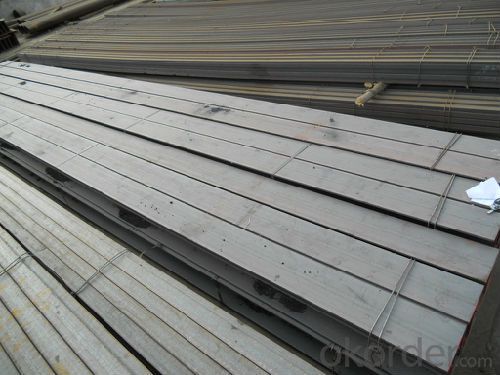
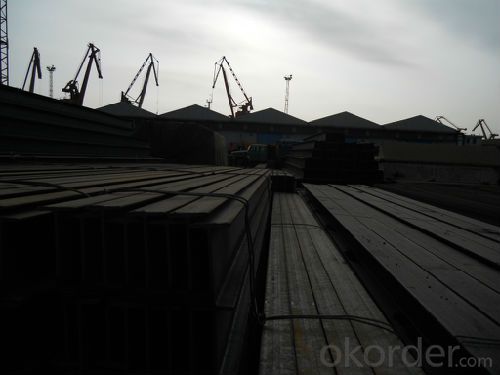

- Q:How do steel H-beams contribute to the overall functionality of a building?
- Steel H-beams play a crucial role in the overall functionality of a building by providing structural support and stability. These beams are designed to withstand heavy loads and distribute weight evenly across the building's framework. One of the main contributions of steel H-beams is their ability to span long distances without the need for intermediate support columns. This allows for open, flexible floor plans and eliminates the need for excessive interior columns, maximizing usable space within the building. Furthermore, steel H-beams have excellent load-bearing capacity, making them ideal for supporting multi-story structures. The beams can withstand various external forces such as wind, earthquakes, and heavy snow loads, ensuring the building's stability and safety. Steel H-beams also contribute to the overall functionality of a building by allowing for efficient construction. Due to their standardized shape and size, these beams can be easily manufactured and transported to the construction site. Additionally, their lightweight nature reduces the overall weight of the building, leading to cost savings in foundation and construction materials. Moreover, steel H-beams are highly durable and resistant to corrosion, making them a long-lasting structural component. This durability ensures the longevity of the building and reduces the need for frequent maintenance or repairs. In summary, steel H-beams contribute significantly to the overall functionality of a building by providing structural support, stability, and flexibility in design. Their ability to withstand heavy loads, span long distances, and resist external forces enhances the safety, efficiency, and longevity of the structure.
- Q:Are steel H-beams fire-resistant?
- Steel H-beams are generally considered to be fire-resistant. This is because steel is a non-combustible material that does not burn or contribute to the spread of fire. In addition, steel has a high melting point, making it more resistant to heat and fire. However, it is important to note that while the steel beams themselves may be fire-resistant, other components of the building or structure, such as the connections or the surrounding materials, may not be. Therefore, it is crucial to consider the overall fire safety measures and building codes in place to ensure the overall fire resistance of a structure.
- Q:How do steel H-beams perform in coastal or saltwater environments?
- Steel H-beams perform reasonably well in coastal or saltwater environments, but they require proper maintenance and protective measures to prevent corrosion. The presence of saltwater and high humidity in coastal areas creates a corrosive environment that can accelerate the deterioration of steel. However, steel H-beams are commonly used in coastal construction projects due to their strength, durability, and cost-effectiveness. To ensure their performance and longevity in such environments, several considerations need to be taken into account. Firstly, the use of corrosion-resistant coatings is essential. Applying coatings such as epoxy, zinc, or galvanization can significantly enhance the steel's resistance to saltwater corrosion. These coatings act as a barrier between the steel and the corrosive environment, preventing direct contact and inhibiting the oxidation process. Regular inspections and maintenance are also crucial in coastal or saltwater areas. Inspecting the H-beams for any signs of corrosion, such as rust or pitting, is necessary to identify and address any early stages of deterioration. Any damaged or compromised protective coatings should be repaired or replaced promptly to prevent further corrosion. Furthermore, proper drainage and ventilation systems need to be in place to minimize the accumulation of saltwater and moisture on the steel surfaces. Excessive moisture or prolonged exposure to saltwater can speed up the corrosion process, leading to structural integrity issues. Adequate ventilation allows for the circulation of air, reducing the chances of moisture buildup and providing a more favorable environment for the steel. It is important to note that the performance of steel H-beams in coastal or saltwater environments also depends on the specific grade and quality of steel used. Choosing high-quality corrosion-resistant steel, such as stainless steel or weathering steel, can provide enhanced protection against saltwater corrosion. In conclusion, while steel H-beams can perform well in coastal or saltwater environments, it is crucial to implement proper maintenance and protective measures. Utilizing corrosion-resistant coatings, conducting regular inspections, ensuring proper drainage and ventilation, and selecting high-quality steel can all contribute to their long-term performance and durability in such challenging environments.
- Q:300*200h steel 7 meter span center load the most, can bearing 30 tons?
- Needless to say, it can not be carried so vigorously.Bearing structure refers to itself directly with the various support systems plus transmission of force to the main structure foundation and its joints, including bearing wall, vertical rod, frame column, pier, beam, floor, roof, cable etc..
- Q:What are the considerations when designing for thermal insulation of Steel H-Beams?
- When designing for thermal insulation of Steel H-Beams, there are several considerations that need to be taken into account. These considerations are crucial in order to ensure the effectiveness and efficiency of the thermal insulation system. The following are some important factors to consider: 1. Material Selection: Choosing the right insulation material is of utmost importance. The material should have a high thermal resistance (R-value) to effectively reduce heat transfer. Common insulation materials used for Steel H-Beams include mineral wool, fiberglass, foam boards, and spray foam insulation. Each material has its own advantages and limitations, so selecting the most suitable one is crucial. 2. Insulation Thickness: The thickness of insulation is directly related to its thermal resistance. Thicker insulation generally provides better thermal performance. However, the available space and structural requirements should be considered when determining the insulation thickness. It is important to strike a balance between thermal efficiency and structural integrity. 3. Vapor Barrier: In some cases, it may be necessary to incorporate a vapor barrier along with the insulation. This barrier prevents the migration of moisture into the insulation, which can lead to reduced thermal performance and potential moisture-related issues. The vapor barrier should be carefully installed to ensure its effectiveness. 4. Fire Safety: Steel H-Beams are commonly used in building structures, and fire safety is a critical consideration. The insulation material should have adequate fire resistance properties to prevent the spread of fire. Fire-rated insulation materials or fireproof coatings can be used to enhance the fire resistance of the system. 5. Structural Design: The addition of insulation may impact the structural design of the Steel H-Beams. The increased weight and thickness of the insulation should be accounted for in the structural calculations to ensure the overall stability and integrity of the structure are maintained. 6. Installation: Proper installation of the thermal insulation is essential for achieving the desired thermal performance. The insulation should be installed in a way that eliminates any gaps or voids, as these can act as thermal bridges and compromise the effectiveness of the insulation system. Additionally, attention should be paid to the installation process to prevent any damage to the beams or the insulation itself. In conclusion, designing for thermal insulation of Steel H-Beams requires careful consideration of material selection, insulation thickness, vapor barrier, fire safety, structural design, and proper installation. By addressing these considerations, the thermal insulation system can effectively reduce heat transfer, improve energy efficiency, and maintain the structural integrity of the building.
- Q:How do steel H-beams contribute to sustainable design?
- Steel H-beams contribute to sustainable design by providing structural strength and durability, allowing for the construction of long-lasting and resilient buildings. Their high load-bearing capacity enables the use of fewer materials, reducing resource consumption and minimizing waste. Moreover, steel H-beams are often made from recycled materials, reducing the demand for new raw materials and lowering carbon emissions. Additionally, their versatility and ease of installation make them suitable for various building types and designs, promoting flexibility and adaptability in sustainable construction practices.
- Q:Can Steel H-Beams be used in airport or transportation terminal construction?
- Yes, steel H-beams can be used in airport or transportation terminal construction. They are often utilized in the construction of large-scale structures due to their strength, durability, and ability to support heavy loads. Steel H-beams provide structural stability and can effectively withstand the dynamic forces experienced in airport or transportation terminal environments.
- Q:How do steel H-beams perform in terms of durability?
- Steel H-beams are renowned for their exceptional durability. Their composition and design grant them high resistance to bending, warping, and twisting, thus rendering them highly durable even in the most challenging scenarios. Steel H-beams are manufactured using robust and sturdy materials, like carbon steel or alloy steel, renowned for their exceptional strength and longevity. Furthermore, they are commonly hot-dip galvanized or coated with protective finishes, further augmenting their durability by preventing corrosion and rust formation. These characteristics endow steel H-beams with the ability to withstand heavy loads, extreme weather conditions, and other environmental factors, ensuring their long-lasting durability. All in all, steel H-beams are an optimal choice for structural applications that prioritize durability.
- Q:Are steel H-beams resistant to sound or noise transmission?
- Steel H-beams are not inherently resistant to sound or noise transmission. However, they can be effective in reducing noise transmission if they are properly insulated or treated with soundproofing materials. Steel, being a dense material, has the potential to transmit sound waves easily. Therefore, additional measures need to be taken to minimize noise transmission through steel H-beams. This can be achieved by adding insulation materials such as rubber, foam, or other sound-absorbing materials to the beams. These materials help to absorb and dampen sound vibrations, reducing the amount of noise that passes through the beams. Additionally, proper construction techniques and design considerations, such as creating double walls or using resilient channels, can also help to mitigate sound transmission through steel H-beams. Ultimately, the effectiveness of steel H-beams in resisting sound or noise transmission depends on the specific construction methods and materials used in conjunction with the beams.
- Q:How do steel H-beams perform in areas with high humidity and chemical exposure?
- Steel H-beams are known for their exceptional strength and durability, making them a popular choice for various structural applications. However, when it comes to areas with high humidity and chemical exposure, there are a few factors to consider. In general, steel is highly resistant to humidity and can withstand prolonged exposure without significant degradation. The H-beams' design, with its wide flanges and thick web, contributes to their resistance against moisture and corrosion. The flanges act as a protective barrier, preventing direct contact between the steel and the surrounding environment. Additionally, the steel used in H-beams is typically coated with a protective layer, such as galvanized or painted coatings, further enhancing its resistance to humidity and chemicals. However, it is important to note that prolonged exposure to high humidity and certain aggressive chemicals can still have an impact on the performance of steel H-beams. In extremely corrosive environments, the protective coating may deteriorate over time, leaving the steel vulnerable to rust and corrosion. This can weaken the structural integrity of the beams and compromise their performance. To mitigate these risks, regular maintenance and inspections are essential. In areas with high humidity and chemical exposure, it is recommended to implement a robust maintenance plan that includes periodic cleaning, inspection for any signs of corrosion, and reapplication of protective coatings as needed. Additionally, using stainless steel H-beams instead of carbon steel ones can provide even greater resistance to corrosion in such environments. In summary, while steel H-beams generally perform well in areas with high humidity and chemical exposure, proper maintenance and inspection are crucial to ensure their long-term durability. By implementing a proactive maintenance plan, the structural integrity of the beams can be preserved, ensuring their continued performance in challenging environments.
1. Manufacturer Overview |
|
|---|---|
| Location | |
| Year Established | |
| Annual Output Value | |
| Main Markets | |
| Company Certifications | |
2. Manufacturer Certificates |
|
|---|---|
| a) Certification Name | |
| Range | |
| Reference | |
| Validity Period | |
3. Manufacturer Capability |
|
|---|---|
| a)Trade Capacity | |
| Nearest Port | |
| Export Percentage | |
| No.of Employees in Trade Department | |
| Language Spoken: | |
| b)Factory Information | |
| Factory Size: | |
| No. of Production Lines | |
| Contract Manufacturing | |
| Product Price Range | |
Send your message to us
Hot Rolled Steel channel H BEAM for sale Made In China
- Loading Port:
- Tianjin
- Payment Terms:
- TT or LC
- Min Order Qty:
- 50 m.t.
- Supply Capability:
- 10000 m.t./month
OKorder Service Pledge
OKorder Financial Service
Similar products
New products
Hot products
Related keywords
